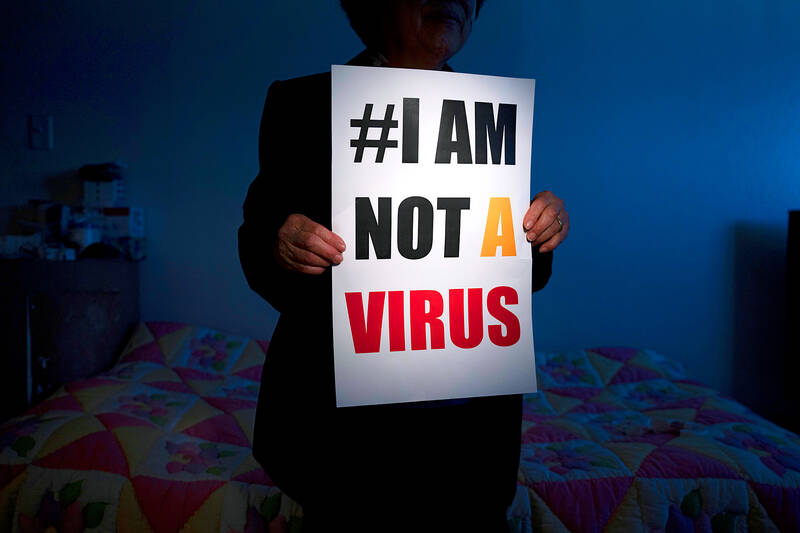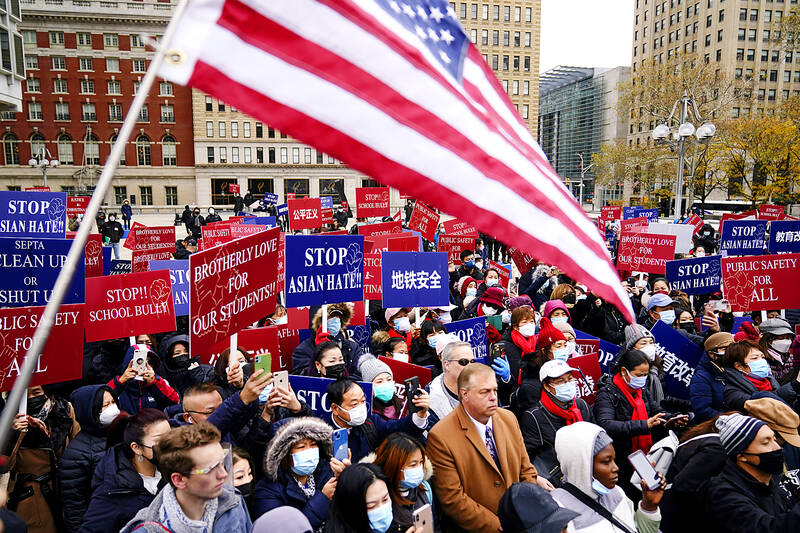Up until 2020, Anna Wong had gone her entire adulthood in Los Angeles without ever facing blatantly racist abuse for being Asian. After COVID-19 hit, she was accosted twice in six months.
The first time, she was browsing an aisle in Bed Bath & Beyond when a white, 30-something woman suddenly yelled: “Six feet away from me, you Chinese witch!”
A shaken Wong left the store, the woman still yelling after her. The second time, Wong was walking her dog when a passenger in a car — a young Hispanic man — screamed at her “Thanks for ruining the world,” followed by an ethnic slur.

Photo: AP
“The first, second year of the pandemic, I do distinctly remember thinking ... I was very nervous to go out,” said Wong, who did not report the incidents to police. “Am I going to draw attention to the fact that I’m Asian?”
It seemed unfathomable she was facing such anti-Asian vitriol nearly a century after her aunt, pioneering movie star Anna May Wong, dealt with constant racial discrimination.
It was five years ago that pandemic-fueled abuse of Asian Americans and Pacific Islanders became so frequent — reports spiked 35 percent from March 2020 to the end of 2021 — that a reporting center was formed. Stop AAPI Hate legitimized fears of a concurrent pandemic of xenophobia. The group’s data prompted national legislative action, including the COVID-19 Hate Crimes Act, and galvanized advocacy among young people within the Asian American community.

Photo: AP
NEW CONCERNS
Five years later, Stop AAPI Hate is receiving fewer incident reports yearly but they’re still happening by the hundreds and are likely an undercount. Now, those still fighting anti-Asian hate are worried it will only intensify in a political climate of immigration crackdowns, English-only mandates and bans on DEI initiatives.
During President Donald Trump’s first term, many partially blamed him for framing COVID-19 with racist language. Trump said his remarks were “not racist at all.” Now, there is concern not just about hate but erasure of Asian American and Pacific Islander history and culture. For example, this month the Pentagon mistakenly took down Web pages honoring Japanese American servicemen.
“What’s the opposite of diversity? It’s segregation or re-segregation,” Manjusha Kulkarni, Stop AAPI Hate co-founder, said, referring to Trump’s policies so far. “They want to put us — people of color, women, LGBTQ — sort of back in our ‘place,’ which means not with access to jobs or housing or ability to celebrate our holidays.”
STOP AAPI HATE
Kulkarni, executive director of the AAPI Equity Alliance, Cynthia Choi of Chinese for Affirmative Action, and San Francisco State University professor Russell Jeung came together in 2020 after a Los Angeles teen of Asian descent was assaulted at school. They solicited accounts of hate acts from victims, even those not legally hate crimes. They received a barrage.
“We said ‘Well, the first thing we need to know and understand is how big of a problem is this,’” Kulkarni said, adding that she will be eternally grateful that people responded. “That helped us to know what was going on.”
Besides federal hate crimes legislation, Stop AAPI Hate’s data led to the passing of three California bills. These included expanding civil rights protection in public spaces and studying hate-driven harassment on public transit. They’ve also attempted social media campaigns like “Spread AAPI Love,” the opposite of their moniker.
Even though the pandemic has abated, their data shows racism prevails. From March 2020 to the end of 2023, Stop AAPI Hate collected over 12,000 reports though they believe it’s likely an undercount. Over 700 occurred in 2023. Figures for 2024 will be released in May.
Also in 2023, an AAPI Data and Associated Press-NORC poll found a third of Asian Americans and Pacific Islanders say they have experienced an act of abuse based on their race or ethnicity in the last year.
An FBI analysis from that year found out of 7,049 reported hate crime offenses motivated by race, ethnicity or ancestry, 6.6 percent involved anti-Asian bias. Kash Patel, the first person of color and Asian American to be agency director, talked about being subjected to racism during his confirmation hearing.
ACTIVISM
There was a groundswell of Asian American activism after 2020, according to Stop AAPI Hate. Their 2023 report found nearly 3 in 4 Asian American and Pacific Islander adults participated in activities to reduce or resist racism.
William Diep, who was 16 in 2020, was disturbed by attacks he heard about in New York City. So he started a campaign, “Virus: Racism.” He virtually gathered testimonies from young people about anti-Asian encounters. The project deeply affected him.
“I learned to stick up for people,” said Diep, now a senior at Columbia University.
He wonders how advocates can navigate the current political climate and if government resources such as translations or race-based census research will be eliminated.
“I’m scared that there’s no one to protect Asian Americans,” Diep said. “I think Asian Americans protect each other, but I question the infrastructure that exists to protect our rights and our heritage.”
Stop AAPI Hate does rely on some federal funding. Ideally, neither the government nor any other outside force will be able to dictate or hamper the organization’s work.
“We hope not. I mean, we’re fighting as hard as we can,” Kulkarni said.
Now, the coalition’s focus has expanded to include educating people about issues like birthright citizenship, cultural school curriculum and immigrants’ rights. Some Asian legal U.S. residents say they are being targeted for deportation.
“I hope and strongly believe that our communities are stronger, that we’re more equipped to handle the challenges of today, which are even more significant than they were in 2020,” Kulkarni said. “We were built for this and our values remain the same.”

That US assistance was a model for Taiwan’s spectacular development success was early recognized by policymakers and analysts. In a report to the US Congress for the fiscal year 1962, former President John F. Kennedy noted Taiwan’s “rapid economic growth,” was “producing a substantial net gain in living.” Kennedy had a stake in Taiwan’s achievements and the US’ official development assistance (ODA) in general: In September 1961, his entreaty to make the 1960s a “decade of development,” and an accompanying proposal for dedicated legislation to this end, had been formalized by congressional passage of the Foreign Assistance Act. Two

March 31 to April 6 On May 13, 1950, National Taiwan University Hospital otolaryngologist Su You-peng (蘇友鵬) was summoned to the director’s office. He thought someone had complained about him practicing the violin at night, but when he entered the room, he knew something was terribly wrong. He saw several burly men who appeared to be government secret agents, and three other resident doctors: internist Hsu Chiang (許強), dermatologist Hu Pao-chen (胡寶珍) and ophthalmologist Hu Hsin-lin (胡鑫麟). They were handcuffed, herded onto two jeeps and taken to the Secrecy Bureau (保密局) for questioning. Su was still in his doctor’s robes at

Last week the Democratic Progressive Party (DPP) said that the budget cuts voted for by the China-aligned parties in the legislature, are intended to force the DPP to hike electricity rates. The public would then blame it for the rate hike. It’s fairly clear that the first part of that is correct. Slashing the budget of state-run Taiwan Power Co (Taipower, 台電) is a move intended to cause discontent with the DPP when electricity rates go up. Taipower’s debt, NT$422.9 billion (US$12.78 billion), is one of the numerous permanent crises created by the nation’s construction-industrial state and the developmentalist mentality it

Experts say that the devastating earthquake in Myanmar on Friday was likely the strongest to hit the country in decades, with disaster modeling suggesting thousands could be dead. Automatic assessments from the US Geological Survey (USGS) said the shallow 7.7-magnitude quake northwest of the central Myanmar city of Sagaing triggered a red alert for shaking-related fatalities and economic losses. “High casualties and extensive damage are probable and the disaster is likely widespread,” it said, locating the epicentre near the central Myanmar city of Mandalay, home to more than a million people. Myanmar’s ruling junta said on Saturday morning that the number killed had